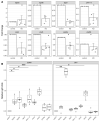Antiviral RNAi Response in Culex quinquefasciatus-Derived HSU Cells
- PMID: 36851650
- PMCID: PMC9968050
- DOI: 10.3390/v15020436
Antiviral RNAi Response in Culex quinquefasciatus-Derived HSU Cells
Abstract
Culex spp. mosquitoes are important vectors of viruses, such as West Nile virus, Eastern equine encephalitis virus and Rift valley fever virus. However, their interactions with innate antiviral immunity, especially RNA interference (RNAi), are not well known. Most research on RNAi pathways in mosquitoes is focused on the tropical vector mosquito Aedes aegypti. Here, we investigated the production of arbovirus-specific small RNAs in Cx. quinquefasciatus-derived HSU cells. Furthermore, by silencing RNAi-related proteins, we investigated the antiviral role of these proteins for two different arboviruses: Semliki Forest virus (SFV) and Bunyamwera orthobunyavirus (BUNV). Our results showed an expansion of Ago2 and Piwi6 in Cx. quinquefasciatus compared to Ae. aegypti. While silencing Ago2a and Ago2b increased BUNV replication, only Ago2b showed antiviral activity against SFV. Our results suggest differences in the function of Cx. quinquefasciatus and Ae. aegypti RNAi proteins and highlight the virus-specific function of these proteins in Cx. quinquefasciatus.
Keywords: Aedes aegypti; Culex quinquefasciatus; RNA interference; RNAi; antiviral immunity.
Conflict of interest statement
The authors declare no conflict of interest.
Figures




References
-
- Lewis S.H., Quarles K.A., Yang Y., Tanguy M., Frézal L., Smith S.A., Sharma P.P., Cordaux R., Gilbert C., Giraud I., et al. Pan-Arthropod Analysis Reveals Somatic PiRNAs as an Ancestral Defence against Transposable Elements. Nat. Ecol. Evol. 2018;2:174–181. doi: 10.1038/s41559-017-0403-4. - DOI - PMC - PubMed
Publication types
MeSH terms
Grants and funding
LinkOut - more resources
Full Text Sources
Miscellaneous

